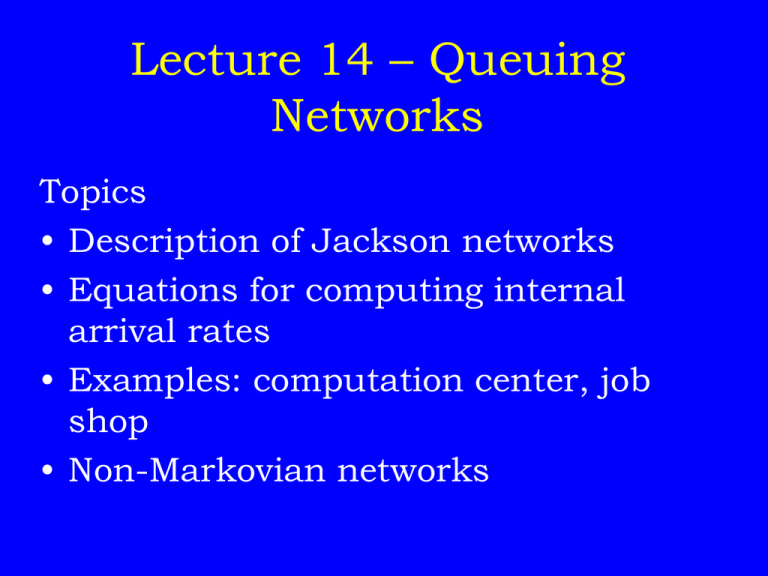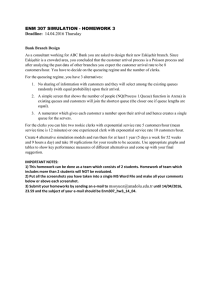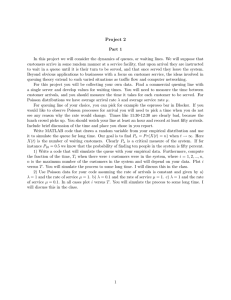Lecture 14 – Queuing Networks
advertisement

Lecture 14 – Queuing
Networks
Topics
• Description of Jackson networks
• Equations for computing internal
arrival rates
• Examples: computation center, job
shop
• Non-Markovian networks
Structure of Single Queuing Systems
Input
source
Arriving
customers
Queue
Service
mechanism
Exiting
customers
Note
1. Customers need not be people parts, vehicles,
machines, jobs.
2. Queue might not be a physical line customers
on hold, jobs waiting to be printed, planes circling airport.
Queuing Networks
In many applications, an arrival has to pass through a
series of queues arranged in a network structure.
Jackson Network Definition
1. All outside arrivals to each queuing station in the
network must follow a Poisson process.
2. All service times must be exponentially distributed.
3. All queues must have unlimited capacity.
4. When a job leaves one station, the probability that
it will go to another station is independent of its
past history and is independent of the location of
any other job.
In essence, a Jackson network is a collection of
connected M/M/s queues with known parameters.
Jackson’s Theorem
1. Each node is an independent queuing system with
Poisson input determined by partitioning, merging
and tandem queuing example.
2. Each node can be analyzed separately using
M/M/1 or M/M/s model.
3. Mean delays at each node can be added to
determine mean system (network) delays.
Computation of Input Rate
Let gi = external arrival rate to station i = 1, . . . , m
fki = probability of going from station k to i in
network
li = total input to station i
In steady state there must be flow balance at
each station.
m
li g i fki lk , i 1,..., m
k 1
Element of a Queuing Network
Jackson Networks
Station 1
1
Two-stage
example.
(1 f1 j)l1
2
l
s1
f1 j l1
.
.
.
Each station
is M /M /s
queue.
gj
Station j
lj
1
2
Station v
1
lv
sj
fvj lv
2
sv
(1 f
vj)lv
lj
Matrix Form of Computations
Property 1: Let be the m m probability matrix that describes
the routing of units within a Jackson network, and let
gi denote the mean arrival rate of units going directly
to station i from outside the system. Then
l = g(I – )–1
where g = (g1,…,gm) and the components of the vector l
give the arrival rates into the various station; that is, li
is the net rate into station i.
Note: Unlike the state-transition matrix used for Markov chains,
the rows of the matrix here need not sum to one; that is
Sj fij ≤ 1
Simplification of Network
After the net rate into each node is known, the network
can be decomposed and each node treated as if it were
an independent queuing system with Poisson input.
Property 2: Consider a Jackson network comprising m nodes.
Let Ni denote a random variable indicating the
number of jobs at node i (the number in the queue
plus the number in service). Then,
Pr{ N1 = n1, …, Nm = nm } = Pr{ N1 = n1}
… Pr{ Nm = nm }
and
Pr{ Ni = ni} for all ni = 0, 1, … can be calculated using the
equations for independent M/M/s seen previously.
Computation Center Example
• A high performance computation center is composed of 3
work stations comprising: (1) input processors, (2) central
computers, and (3) a print center.
• All jobs submitted must first pass through an input
processor for error checking before moving on to a central
processor 80% go through and 20% are rejected.
• Of the jobs that pass through the central processor, 40%
are routed to a printer.
• Jobs arrive randomly at the computation center at an
average rate of 10/min. To handle the load, each station
may have several parallel processors.
Data for the Computation Center
We know from previous statistics that the time for the
three steps have exponential distributions with means as
follows:
10 seconds for an input processor
5 seconds for a central processor
70 seconds for a graphic processor
All queues are assumed to have unlimited capacity.
Goal
Model system as a Jackson network. Find the minimum
number of processors of each type and compute the
average time require for a job to pass through the system.
Arrival Rate Computations
Using general equation:
m
li g i fki lk
k 1
With m = 3, g1 = 10, f12 = 0.8, f23 = 0.4
we get:
l1 = 0
l2 = 0.8l1 = 8
l3 = 0.4l2 = 3.2
I/O Data for the Computation Center
Input
processor
Central
processor
Printer
External arrival rate, gi
10/min
0
0
Total arrival rate, li
10/min
8/min
3.2/min
Service rate, mi
6/min
20/min
0.857/min
2
1
4
0.833
0.400
0.933
System measure
Minimum channels, si
Traffic intensity, ri
Results for Computation Center
Input
Central
Printer
Measure
processor
processor
station
Model
M/M/2
M/M/1
M/M/4
Lq
3.788
0.267
12.023
16.077
Wq
0.379
0.033
3.757
4.169
L
1.667
0.400
3.734
5.801
Ws
0.167
0.050
1.167
1.384
Total
Job Shop Example
Scenario
• Three products
• Four machines: A, B, C, D
• Each class takes different route
• Data
Product
Order rate
Route
1
30/mo
A-B-D-F
2
10/mo
A-B-E-F
3
20/mo
A-C-E-F
Network for Shop Shop
Machine B
s=2
m = 22
gA = 60
Machine A
s=3
m = 25
Machine D
s=3
m = 11
Machine E
s=2
m = 23
Machine C
s=1
m = 29
Machine F
s=4
m = 20
Results for Job Shop Example
Measure
A
B
C
D
E
F
g
60
0
0
0
0
0
m
25
22
29
11
23
20
s
3
2
1
3
2
4
Model
M/M/3
M/M/2
M/M/1
M/M/3
M/M/2
M/M/4
l
60
40
20
30
30
60
r
0.800
0.909
0.690
0.909
0.652
0.750
L
4.989
10.476
2.222
11.059
2.270
4.528
W
0.083
0.262
0.111
0.369
0.076
0.075
Lq
2.589
8.658
1.533
8.332
0.965
1.528
Wq
0.043
0.216
0.077
0.278
0.032
0.025
System Performance Measures
•
Manufacturing lead time
– Average time a product spends in the system
– Summation of time spent in each M/M/s system
•
Work-in-process (WIP) inventory
– Computed from Little’s law
– WIP = (lead time) (order rate)
•
Questions: Can we sum L in each M/M/s queue to
get WIP ?
System Performance for Job Shop
Order
rate
Product (per mo.)
Lead
time
Queue
time
WIP
Route
(mo.)
(mo.)
(units)
1
30
A-B-D-F
0.789
0.563
23.67
2
10
A-B-E-F
0.496
0.317
4.96
3
20
A-C-E-F
0.345
0.177
6.91
• WIP determined with Little’s law = (lead time) (order rate).
• Results show a marked difference between the products in
terms of lead time and WIP since product 1 passes through
both stations B and D.
Non-Markov Networks
• Assume we have a network with K classes of customers.
• Each class k K has a fixed routing through the
network.
• Unlimited capacity at each node.
• Arrival and service processes not known, but means and
standard deviations of interarrival times and service
times are known.
View each station as an GI/G/1 queue.
A Jackson network can be used to
approximate this network.
Non-Markov Network Example
Station 1
l
ma,d1
ma, a
Station 2
ms1, s1
ma, d2
Station 3
ms2,s2
ma, d3
ms, s3
3
Let msi = mean processing time at station i for i = 1, 2, 3
si = standard deviation of processing time at station i
Data:
Arrival data
ma
a
ca
Service data
5
2
0.
ms
s
cd
Station 1 Station 2 Station 3
4
2
0.5
4
2
0.5
4
2
0.5
Example (continued)
• Mean time between arrivals is ma = 5 minutes so l = 0.2/min.
• Mean time between departures at station 1, and equivalently the
mean time between arrivals at stations 2, is the same ma.
• Similarly, the departures from stations 2 and 3 all have the same
mean, ma.
• Standard deviation of the time between departures d1, d2 and
d3, will differ, however, because of the joint effects of arrival
and service variability on departure variability.
The approximate relation is
cd2 = r 2cs2 + (1 – r 2)ca2 and d = cd ma
The departure coefficient of variation is the same as the arrival
coefficient of variation of the next stage.
Results for Non-Markov Network Example
Queues can be analyzed sequentially starting with station 1 using
the formula
ca2 + cs2
Wq (GI / G / 1)
Wq (M / M / 1)
2
Results
2
ca
2
cs
Station 1
Station 2
Station 3
0.16
0.25
0.218
0.25
0.448
0.25
r
0.8
0.8
0.8
Total
Wq(M/M/1)
16
16
16
48
Wq(GI/G/1)
3.74
3.90
3.96
11.61
At each station: W = Wq + 1/m
Use Little’s law to find L and Lq with l = 0.2/min for each station.
What You Should Know About
Queuing Networks
• The assumptions underlying a
Jackson network.
• How to compute the internal arrival
rates.
• How to evaluate performance of a
Jackson network.
• The extent to which non-Poisson
networks can be analyzed.



